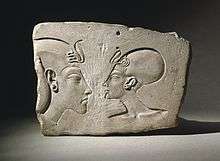Khat (apparel)
The khat was a head cloth worn by the nobility of Ancient Egypt. Simpler than the nemes head-dress, it did not have pleats or stripes, and hung down open in the back rather than being tied together.[1]

The Wilbour Plaque, ca. 1352–1336 B.C.E., 16.48, Brooklyn Museum; On the left is the head of a king, most probably a representation of Akhenaten, who wears the baglike khat headdress with a royal uraeus. Opposite him is the head of a queen wearing the ovoid cap crown often worn by Nefertiti, also with a uraeus.
History
The khat dates to the reign of the First Dynasty king Den at least. On an ivory label found at Abydos, Den is shown wearing the khat and brandishing a mace.[2]
Archaeological examples made of linen have been found.[3]
gollark: I actually executed a Trusting Trust attack on macronc.
gollark: All the cool things are statements and not expressions.
gollark: Python is frequently very mean to golfing.
gollark: You're right actually, yes.
gollark: Not sure.
References
- Toby A. H. Wilkinson, Early Dynastic Egypt, Routledge 1999
Notes
- Brooklyn Museum online Ancient Egypt glossary. Accessed March 29, 2006.
- Wilkinson, op.cit., p.196
- Griffith Institute: Carter Archives - 256-4pbi. Accessed January 8, 2012.
This article is issued from Wikipedia. The text is licensed under Creative Commons - Attribution - Sharealike. Additional terms may apply for the media files.